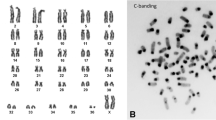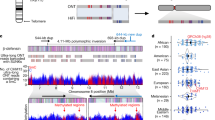Abstract
Copy number differences (CNDs), and the concomitant differences in gene number, have contributed significantly to the genomic divergence between humans and other primates. To assess its relative importance, the genomes of human, common chimpanzee, bonobo, gorilla, orangutan and macaque were compared by comparative genomic hybridization using a high-resolution human BAC array (aCGH). In an attempt to avoid potential interference from frequent intra-species polymorphism, pooled DNA samples were used from each species. A total of 322 sites of large-scale inter-species CND were identified. Most CNDs were lineage-specific but frequencies differed considerably between the lineages; the highest CND frequency among hominoids was observed in gorilla. The conserved nature of the orangutan genome has already been noted by karyotypic studies and our findings suggest that this degree of conservation may extend to the sub-microscopic level. Of the 322 CND sites identified, 14 human lineage-specific gains were observed. Most of these human-specific copy number gains span regions previously identified as segmental duplications (SDs) and our study demonstrates that SDs are major sites of CND between the genomes of humans and other primates. Four of the human-specific CNDs detected by aCGH map close to the breakpoints of human-specific karyotypic changes [e.g., the human-specific inversion of chromosome 1 and the polymorphic inversion inv(2)(p11.2q13)], suggesting that human-specific duplications may have predisposed to chromosomal rearrangement. The association of human-specific copy number gains with chromosomal breakpoints emphasizes their potential importance in mediating karyotypic evolution as well as in promoting human genomic diversity.


Similar content being viewed by others
References
Armengol L, Pujana MA, Cheung J, Scherer SW, Estivill X (2003) Enrichment of segmental duplications in regions of breaks of synteny between the human and mouse genomes suggest their involvement in evolutionary rearrangements. Hum Mol Genet 12:2201–2208
Bailey JA, Yavor AM, Massa HF, Trask BJ, Eichler EE (2001) Segmental duplications: organization and impact within the current human genome project assembly. Genome Res 11:1005–1017
Bailey JA, Gu Z, Clark RA, Reinert K, Samonte RV, Schwartz S, Adams MD, Myers EW, Li PW, Eichler EE (2002a) Recent segmental duplications in the human genome. Science 297:1003–1007
Bailey JA, Yavor AM, Viggiano L, Misceo D, Horvath JE, Archidiacono N, Schwartz S, Rocchi M, Eichler EE (2002b) Human-specific duplication and mosaic transcripts: the recent paralogous structure of chromosome 22. Am J Hum Genet 70:83–100
Bailey JA, Liu G, Eichler EE (2003) An Alu transposition model for the origin and expansion of human segmental duplications. Am J Hum Genet 73:823–834
Brewer C, Holloway S, Zawalnyski P, Schinzel A, FitzPatrick D (1999) A chromosomal duplication map of malformations: regions of suspected haplo- and triplolethality- and tolerance of segmental aneuploidy–in humans. Am J Hum Genet 64:1702–1708
Britten RJ (2002) Divergence between samples of chimpanzee and human DNA sequences is 5%, counting indels. Proc Natl Acad Sci USA 99:13633–13635
Chen FC, Li WH (2001) Genomic divergences between humans and other hominoids and the effective population size of the common ancestor of humans and chimpanzees. Am J Hum Genet 68:444–456
Cheng Z, Ventura M, She X, Khaitovich P, Graves T, Osoegawa K, Church D, DeJong P, Wilson RK, Pääbo S, Rocchi M, Eichler EE (2005) A genome-wide comparison of recent chimpanzee and human segmental duplications. Nature 437:88–93
Cheung J, Wilson MD, Zhang J, Khaja R, MacDonald JR, Heng HH, Koop BF, Scherer SW (2003) Recent segmental and gene duplications in the mouse genome. Genome Biol 4:R47
Cowell JK, Nowak NJ (2003) High resolution analysis of genetic events in cancer cells using BAC arrays and CGHa. Adv Cancer Res 90:91–125
Dennehey BK, Gutches DG, McConkey EH, Krauter KS (2004) Inversion, duplication, and changes in gene context are associated with human chromosome 18 evolution. Genomics 83:493–501
Fan Y, Linardopoulou E, Friedman C, Williams E, Trask BJ (2002) Genomic structure and evolution of the ancestral chromosome fusion site in 2q13–2q14.1 and paralogous regions on other human chromosomes. Genome Res 12:1651–1662
Fortna A, Kim Y, MacLaren E, Marshall K, Hahn G, Meltesen L, Brenton M, Hink R, Burgers S, Hernandez-Boussard T, Karimpour-Fard A, Glueck D, McGavran L, Berry R, Pollack J, Sikela JM (2004) Lineage-specific gene duplication and loss in human and great ape evolution. PLoS Biol 2:E207
Frazer KA, Chen X, Hinds DA, Pant PV, Patil N, Cox DR (2003) Genomic DNA insertions and deletions occur frequently between humans and nonhuman primates. Genome Res 13:341–346
Gilad Y, Bustamante CD, Lancet D, Pääbo S (2003) Natural selection on the olfactory receptor gene family in humans and chimpanzees. Am J Hum Genet 73:489–501
Gilad Y, Man O, Glusman G (2005) A comparison of the human and chimpanzee olfactory receptor gene repertoires. Genome Res 15:224–230
Glazko GV, Nei M (2003) Estimation of divergence times for major lineages of primate species. Mol Biol Evol 20:424–434
Goidts V, Szamalek JM, Hameister H, Kehrer-Sawatzki H (2004) Segmental duplication associated with the human-specific inversion of chromosome 18: further example of the impact of segmental duplications on karyotype and genome evolution in primates. Hum Genet 115:116–122
Horvath JE, Gulden CL, Bailey JA, Yohn C, McPherson JD, Prescott A, Roe BA, de Jong PJ, Ventura M, Misceo D, Archidiacono N, Zhao S, Schwartz S, Rocchi M, Eichler EE (2003) Using a pericentromeric interspersed repeat to recapitulate the phylogeny and expansion of human centromeric segmental duplications. Mol Biol Evol 20:1463–1479
Iafrate AJ, Feuk L, Rivera MN, Listewnik ML, Donahoe PK, Qi Y, Scherer SW, Lee C (2004) Detection of large-scale variation in the human genome. Nat Genet 36:949–951
Jorgensen PM, Graslund S, Betz R, Stahl S, Larsson C, Hoog C (2001) Characterisation of the human APC1, the largest subunit of the anaphase-promoting complex. Gene 262:51–59
Jurka J (2004) Evolutionary impact of human Alu repetitive elements. Curr Opin Genet Dev 14:603–608
Kapitonov V, Jurka J (1996) The age of Alu subfamilies. J Mol Evol 42:59–65
Kent WJ, Sugnet CW, Furey TS, Roskin KM, Pringle TH, Zahler AM, Haussler D (2002) The human genome browser at UCSC. Genome Res 12:996–1006
Liu G, Zhao S, Bailey JA, Sahinalp SC, Alkan C, Tuzun E, Green ED, Eichler EE (2003) Analysis of primate genomic variation reveals a repeat-driven expansion of the human genome. Genome Res 13:358–368
Locke DP, Segraves R, Carbone L, Archidiacono N, Albertson DG, Pinkel D, Eichler EE (2003) Large-scale variation among human and great ape genomes determined by array comparative genomic hybridization. Genome Res 13:347–357
Magness CL, Campion Fellin P, Thomas MJ, Korth MJ, Agy MB, Proll SC, Fitzgibbon M, Scherer CA, Miner DG, Katze MG, Iadonato SP (2005) Analysis of the Macaca Mulatta transcriptome and the sequence divergence between Macaca and human. Genome Biol 6:R60
Mueller S, Wienberg J (2001) “Bar-coding” primate chromosomes: molecular cytogenetic screening for the ancestral hominoid karyotype. Hum Genet 109:85–94
Samonte RV, Eichler EE (2002) Segmental duplications and the evolution of the primate genome. Nat Rev Genet 3:65–72
Sebat J, Lakshmi B, Troge J, Alexander J, Young J, Lundin P, Maner S, Massa H, Walker M, Chi M, Navin N, Lucito R, Healy J, Hicks J, Ye K, Reiner A, Gilliam TC, Trask B, Patterson N, Zetterberg A, Wigler M (2004) Large-scale copy number polymorphism in the human genome. Science 305:525–528
Sharp AJ, Locke DP, McGrath SD, Cheng Z, Bailey JA, Vallente RU, Pertz LM, Clark RA, Schwartz S, Segraves R, Oseroff VV, Albertson DG, Pinkel D, Eichler EE (2005) Segmental duplications and copy-number variation in the human genome. Am J Hum Genet 77:78–88
Shaw CJ, Lupski JR (2004) Implications of human genome architecture for rearrangement-based disorders: the genomic basis of disease. Hum Mol Genet 13:R57–R64
Shen MR, Batzer M, Deininger P (1991) Evolution of the master Alu gene(s). J Mol Evol 33:311–320
Snijders AM, Nowak N, Segraves R, Blackwood S, Brown N, Conroy J, Hamilton G, Hindle AK, Huey B, Kimura K, Law S, Myambo K, Palmer J, Ylstra B, Yue JP, Gray JW, Jain AN, Pinkel D, Albertson DG (2001) Assembly of microarrays for genome-wide measurement of DNA copy number. Nat Genet 29:263–264
Tuzun E, Bailey JA, Eichler EE (2004) Recent segmental duplications in the working draft assembly of the Brown Norway rat. Genome Res 14:493–506
Tuzun E, Sharp AJ, Bailey JA, Kaul R, Morrison VA, Pertz LM, Haugen E, Hayden H, Albertson D, Pinkel D, Olson MV, Eichler EE (2005) Fine-scale structural variation of the human genome. Nat Genet 37:727–732
Yunis JJ, Prakash O (1982) The origin of man: a chromosomal pictorial legacy. Science 215:1525–1530
Acknowledgements
We thank Antje Kollak, Helene Spöri and Stefanie Raith for technical assistance. This research was funded by the Deutsche Forschungsgemeinschaft (DFG KE 724/2-1). L.A. and X.E. are supported by Genome Spain and the “Generaliyay de Catalunya”.
Author information
Authors and Affiliations
Corresponding author
Electronic supplementary material
Rights and permissions
About this article
Cite this article
Goidts, V., Armengol, L., Schempp, W. et al. Identification of large-scale human-specific copy number differences by inter-species array comparative genomic hybridization. Hum Genet 119, 185–198 (2006). https://doi.org/10.1007/s00439-005-0130-9
Received:
Accepted:
Published:
Issue Date:
DOI: https://doi.org/10.1007/s00439-005-0130-9




